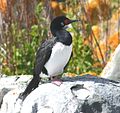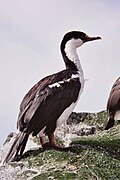Blue-eyed shag
| Blue-eyed shags | |
|---|---|
| South Georgia shag Phalacrocorax georgianus | |
| Scientific classification | |
| Domain: | Eukaryota |
| Kingdom: | Animalia |
| Phylum: | Chordata |
| Class: | Aves |
| Order: | Suliformes |
| Family: | Phalacrocoracidae |
| Genus: | Leucocarbo Bonaparte, 1856 |
| Type species | |
| Carbo bougainvillii (guanay cormorant) Lesson, 1837
| |
| Species | |
|
See text | |
| Synonyms | |
|
Phalacrocorax (in part) | |
Leucocarbo is a genus of birds in the family Phalacrocoracidae. Several species within the genus are collectively known as blue-eyed shags. This is a group of closely related cormorant taxa. Many have a blue, purple or red ring around the eye (not a blue iris); other shared features are white underparts (at least in some individuals) and pink feet.[1]
They are found around the colder parts of the Southern Hemisphere, especially near southern South America, Antarctica, and New Zealand. Many are endemic to remote islands. Determining which types are species and which are subspecies of what larger species is problematic; various recent authorities have recognized from 8 to 14 species and have placed them in a variety of genera. The common names are even more confusing, "like myriad footprints criss-crossing in the snow and about as easy to disentangle." Only one common name is given for most species here.[1]
Taxonomy
[edit]The genus Leucocarbo was introduced in 1856 by the French naturalist Charles Lucien Bonaparte.[2] He did not specify a type species but this was designated as the guanay cormorant by William Ogilvie-Grant in 1898.[3][4] The name Leucocarbo combines the Ancient Greek leukos meaning "white" with the genus name Carbo introduced by Bernard Germain de Lacépède in 1799.[5]
A molecular phylogenetic study published in 2014 found that Leucocarbo is sister to the American cormorants in the genus Nannopterum; the genera split between 6.7 - 8.0 million years ago.[6]
The genus contains 16 species:[7]
| Image | Scientific name | Common Name | Distribution |
|---|---|---|---|
 |
Leucocarbo magellanicus | Rock shag or Magellanic cormorant | The coast of Argentina, Uruguay and southern Chile. |
 |
Leucocarbo bougainvillii | Guanay cormorant | The western coast of South America (Extirpated from Argentina). |
 |
Leucocarbo ranfurlyi | Bounty shag | Bounty Islands. |
 |
Leucocarbo carunculatus | New Zealand king shag, rough-faced shag or kawau | New Zealand. |
 |
Leucocarbo onslowi | Chatham shag | Chatham Islands. |
 |
Leucocarbo chalconotus | Otago shag | Eastern coast of New Zealand. |
 |
Leucocarbo stewarti | Foveaux shag | Stewart Island and the Foveaux Strait. |
 |
Leucocarbo colensoi | Auckland shag | Auckland Islands. |
 |
Leucocarbo campbelli | Campbell shag | Campbell Island. |
 |
Leucocarbo atriceps | Imperial shag or blue-eyed shag | Southern Chile and Argentina. |
 |
Leucocarbo georgianus | South Georgia shag | South Georgia and the Shag Rocks. |
 |
Leucocarbo melanogenis | Crozet shag | Crozet Island, Prince Edward Island and Marion Island. |
 |
Leucocarbo bransfieldensis | Antarctic shag | The Antarctic Peninsula, South Shetland Islands and Elephant Island. |
 |
Leucocarbo verrucosus | Kerguelen shag | Kerguelen Islands. |
| Leucocarbo nivalis | Heard Island shag | Heard and McDonald Islands. | |
 |
Leucocarbo purpurascens | Macquarie shag | Macquarie Island. |
References
[edit]- ^ a b Nelson, J. Bryan (2006). Pelicans, Cormorants, and Their Relatives: The Pelecaniformes. Oxford University Press, U.S.A. pp. 476–511, Plate 8. ISBN 978-0-19-857727-0.
- ^ Bonaparte, Charles Lucien (1856). "Excusion dans les divers Musées d'Allemagne, de Hollande et de Belgique, et tableaux paralléliques de l'ordre des échassiers (suite)". Comptes Rendus Hebdomadaires des Séances de l'Académie des Sciences (in French). 43: 571–579 [575].
- ^ Sharpe, R.B.; Ogilvie-Grant, W.R. (1898). Catalogue of the Plataleae, Herodiones, Steganopodes, Pygopodes, Alcae and Impennes in the collection of the British Museum. Catalogue of the Birds in the British Museum. Vol. 26. London: Trustees of the British Museum. p. 331.
- ^ Mayr, Ernst; Cottrell, G. William, eds. (1979). Check-List of Birds of the World. Vol. 1 (2nd ed.). Cambridge, Massachusetts: Museum of Comparative Zoology. p. 164.
- ^ Jobling, James A. (2010). The Helm Dictionary of Scientific Bird Names. London: Christopher Helm. p. 223. ISBN 978-1-4081-2501-4.
- ^ Kennedy, M.; Spencer, H.G. (2014). "Classification of the cormorants of the world". Molecular Phylogenetics and Evolution. 79: 249–257. doi:10.1016/j.ympev.2014.06.020. PMID 24994028.
- ^ Gill, Frank; Donsker, David, eds. (2019). "Hamerkop, Shoebill, pelicans, boobies, cormorants". World Bird List Version 9.1. International Ornithologists' Union. Retrieved 12 April 2019.


